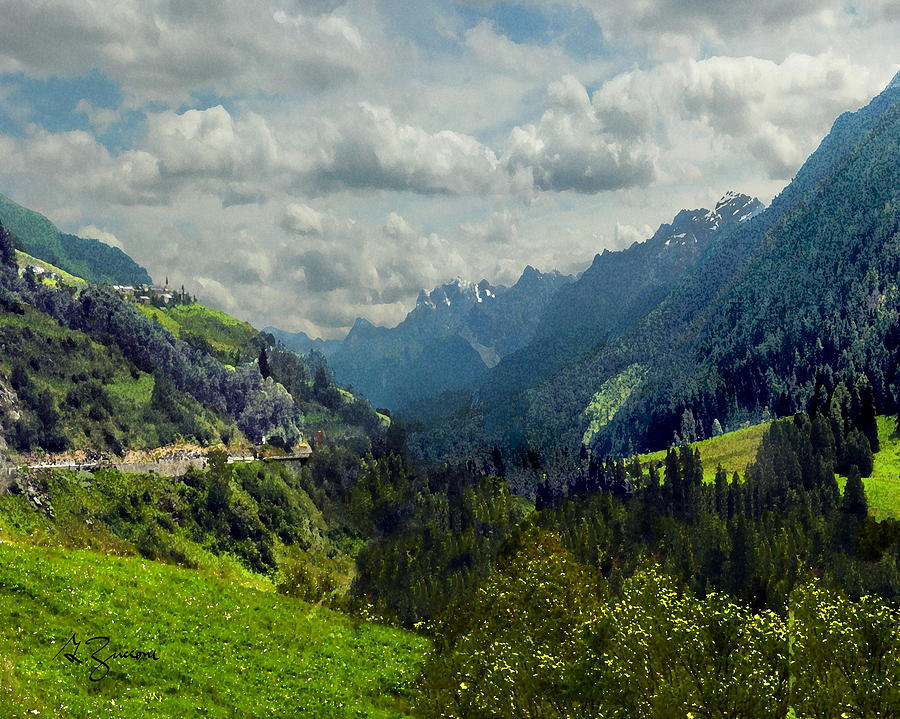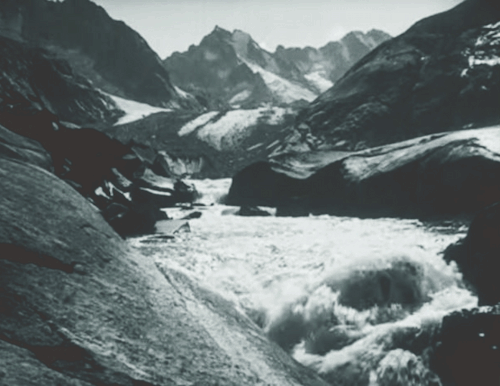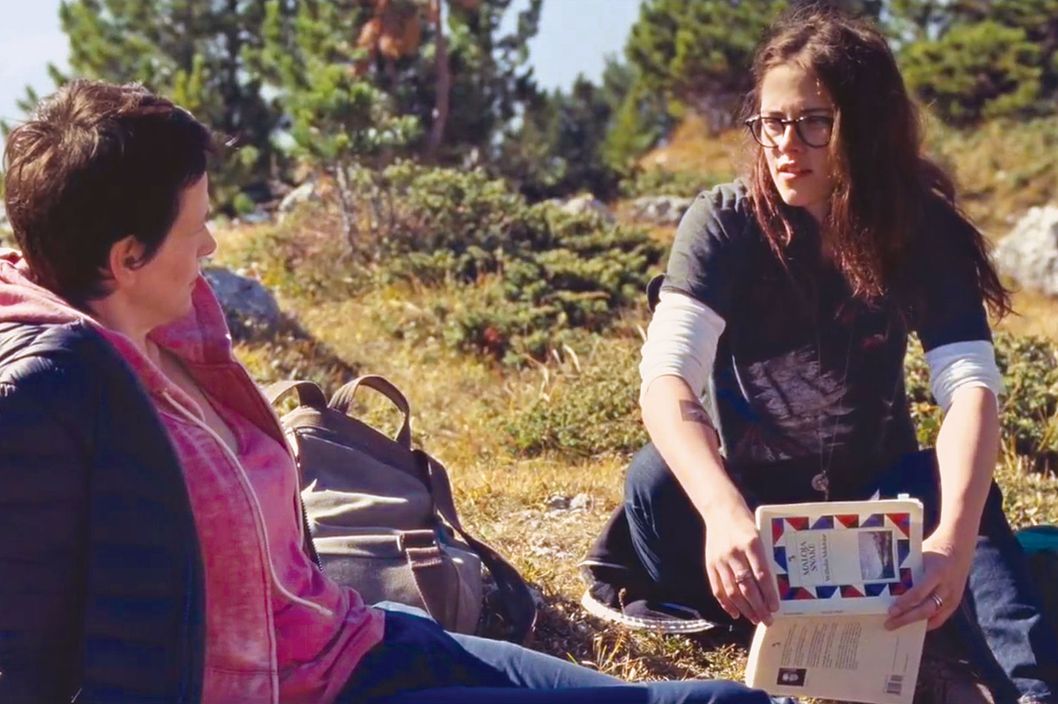Writing to his friend Heinrich Köselitz in 1883, Friedrich
Nietzsche relates finding “the first outline of the thought related to
[Zarathustra]. Underneath it says ‘Beginning August 1881; in Sils Maria; 6000
feet above the sea, and even higher above all human things.’” In Ecce Homo
(1888), Nietzsche would again write that “The fundamental conception of [Zarathustra],
and the Eternal Recurrence-Thought, this highest affirmation at all attainable
– belongs in August 1881: it was penned on a sheet with the notation underneath,
‘6000 feet beyond man and time.’”
Clearly it was a profound moment for the philosopher, the telling
of which he felt necessary to reiterate: this time, August 1881; this place,
beyond man and time.
 |
| Maloja Pass in the Upper Engadin Valley |
Olivier Assayas’s Clouds of Sils Maria takes us to the exalted place of
Nietzsche’s epiphany – and to denials, contradictions, and paradoxes. Sils Maria is lost to time, all but unchanged since Nietzsche
summered there, yet it sits within intimate proximity to that global jet set destination, St. Moritz, the holy grail of the rich and famous, the
toniest ski resort in the world.
In one regard, Clouds of Sils Maria is a self-reflexive tale about
the dramatic life and the blessings of celebrity and its curse. The film
jostles our perception between reality – at least the reality that is the film
– and the play being analyzed and rehearsed
within it. The distinction starts to blur between our main characters’ spirited
arguments and the playwright’s rehearsed lines, but writer/director Assayas constructs the
dialogue so that we are caught just short of that blurring when the
protagonist’s assistant interjects stage direction.
Just as the voicing of stage direction jolts us into understanding
we are not in reality but the play, Assayas’s editing takes us quite
deliberately in and out of scenes. Fadeouts – if we can call them that, abrupt
as they are, punctuate the film, as Anthony Lane of the New Yorker says, “before
we have readied ourselves” for the transition. They add to the dramatic self-consciousness
of the film by imitating a curtain’s descent at scene's close.
On a deeper level, Clouds of Sils Maria is about the relationship
between youth and age, lived experience and art, and our fundamental identity
in the face of the electronic virtual. Indeed, it asks whether, in the electronic age, the
struggle for self-knowledge has become a quaintly old-fashioned idea.
Assayas limns the film’s outline in a few quick strokes. The story centers on internationally renowned Maria Enders (a stunningly complex Juliette Binoche). Maria owes her stardom to the venerable playwright Wilhelm Melchior, who cast the 18-year-old unknown as the ingénue Sigrid in the stage premier of his play Maloja Snake and then in the film adaptation. The play explores the dynamic – erotic, generational, political – between Helena, who has inherited a family business, and her less than innocent teenage employee, Sigrid, who, by manipulating Helena’s insecurities and growing romantic infatuation, ultimately drives Helena to suicide.
Assayas limns the film’s outline in a few quick strokes. The story centers on internationally renowned Maria Enders (a stunningly complex Juliette Binoche). Maria owes her stardom to the venerable playwright Wilhelm Melchior, who cast the 18-year-old unknown as the ingénue Sigrid in the stage premier of his play Maloja Snake and then in the film adaptation. The play explores the dynamic – erotic, generational, political – between Helena, who has inherited a family business, and her less than innocent teenage employee, Sigrid, who, by manipulating Helena’s insecurities and growing romantic infatuation, ultimately drives Helena to suicide.
We meet Maria a quarter century hence, on a train to
Zurich with her multi-phone wielding personal assistant Val
(Kristen Stewart of Twilight Saga fame in a deeply realized performance). Maria
is to accept a prestigious honor on Melchior’s behalf. He despises awards, and
when Val relays the news of Melchior's sudden, unexpected death,
Maria’s visceral instinct is to retreat back to London as a bow of respect to
the values of her friend and mentor – but she conforms, and will speak for
what now will be a memorial.
We soon learn Maria is being dogged by Klaus Diesterweg (Lars Eidinger), a
theater director – “the best of his generation,” Val tells Maria – who is
anxious to revive Maloja Snake with Maria in the role of the
older woman. After Melchior’s memorial, Diesterweg corners Maria in the
opulent Zurich hotel where the post-ceremony reception is being held, to try
again to convince her to perform in his stage production as Helena – with Jo-Ann Ellis (Chloë Grace Moretz), a paparazzi-baiting celebrity who
cultivates a Lindsay Lohan-esque bad girl-persona, in the role that made Maria
a star.
 |
| Kristen Stewart as Val and Juliette Binoche as Maria in Olivier Assayas's Clouds of Sils Maria |
Melchior’s widow Rosa (Angela Winkler), who lives in the
Upper Engadin – the valley of the Swiss Alps through which flows Lake Sils – invites
Maria and Val to stay at her home in Sils Maria while she is away. “Stay as
long as you want. I like to think that you’re working on your part here where
it was written.”
The title of the play, Maloja Snake, within the play – the film we
are watching, itself self-consciously dramatic and divided into two acts and an
epilogue – is the name of a meteorological phenomenon unique to the Engadin.
In autumn, warm morning air rising up the slopes of the Maloja Pass is
transformed into a low-lying thick, white cloud that wends its
way along the mountainsides. Its annual constancy played a part in shaping Nietzsche’s concept of Eternal Recurrence, and it is the central metaphor
of the film.
Nietzsche called Eternal Recurrence "The greatest weight." In The Gay Science (1882), he poses the scenario: "What, if some day or night a demon were to steal after you into your loneliest loneliness and say to you: 'This life as you now live it and have lived it, you will have to live once more and innumerable times more; and there will be nothing new in it, but every pain and every joy and every thought and sigh and everything unutterably small or great in your life will have to return to you, all in the same succession and sequence – even this spider and this moonlight between the trees, and even this moment and I myself. The eternal hourglass of existence is turned upside down again and again, and you with it, speck of dust!' Would you not throw yourself down and gnash your teeth and curse the demon who spoke thus? Or have you once experienced a tremendous moment when you would have answered him: 'You are a god and never have I heard anything more divine'? If this thought gained possession of you, it would change you as you are, or perhaps crush you."
The night before she sets off, Rosa shows Maria a film, the film that influenced her husband to write his most famous play. Assayas can thus incorporate Arnold Fanck’s hauntingly beautiful 1924 silent Das Wolkenphänomen von Maloja. Though made at the height of German Expressionism, it is more firmly grounded in Romanticism, and the black and white images of the serpentine cloud juxtaposed with the intertitles’ stylized typeface serve as an apt device to transition the narrative from the populated train and the society of the awards ceremony to the film’s second act amidst the isolation of inviolate nature.
 |
| The Maloja Snake |
The night before she sets off, Rosa shows Maria a film, the film that influenced her husband to write his most famous play. Assayas can thus incorporate Arnold Fanck’s hauntingly beautiful 1924 silent Das Wolkenphänomen von Maloja. Though made at the height of German Expressionism, it is more firmly grounded in Romanticism, and the black and white images of the serpentine cloud juxtaposed with the intertitles’ stylized typeface serve as an apt device to transition the narrative from the populated train and the society of the awards ceremony to the film’s second act amidst the isolation of inviolate nature.
This storied site overlooking the Maloja Pass becomes the crucible
where Maria will penetrate deeper into Melchior’s play through the
role of the older Helena and begin to come to terms with her own process of
becoming in the face of aging’s inevitability. The play, which has been so
central to her self-image (Wanting out of her contract, she pleads with
her lawyer, “I am Sigrid! I want to stay Sigrid!”), now becomes her life. In
the remote Engadin, rehearsing lines with Val, Maria wrestles not only with the
truth of the play, but with the truth of herself as an actress and as a woman.
Sils Maria will serve as Val’s crucible as much as Maria’s, the place where she
will, through the medium of Maloja Snake, come to understand that she is
suffocating in Maria’s shadow. Life, that is, will imitate art.
The improvised rehearsals at the house in Sils Maria are at the
film’s core. As they become more and more intense, we come to see the depth of
Maria’s method, but we also start to realize Val’s great sense of obligation.
She serves Maria, not merely as a faithful assistant, but as a smart,
independent thinker; a valuable sounding board; and a devoted
confidante. (Though she holds the script in hand, Val has committed Sigrid’s
part to memory as thoroughly as Maria has Helena’s.) Yet by degrees, Val
questions whether that loyalty may be misplaced in a relationship that is not
reciprocal.
In serving to demonstrate Maria’s commitment to her craft, the
intensity of the rehearsal scenes functions in diametrical opposition to Jo-Ann’s
pop culture celebrity based on roles defined by little more than costumes, set
dressing, and CGI. Hard as Val tries to convince Maria that distinctions
between “high” and “low” are passé (of Jo-Ann’s most recent film and character:
“There’s no less truth in it than in a more serious film.” “I know it’s a silly
convention, but it’s no sillier than any other convention.”), Maria persists in
the belief that aesthetic and ethical concerns about authenticity matter and that
the examined life is necessary to the realization of art. She chides the people
around her for their simplistic readings of both art and life. Yet it is Val
who will admonish Maria: “You can’t be as good as you are, as accomplished as
you are, and still hold on to the privileges of youth.” Clouds of Sils Maria keeps circling the question of the viability of a society that pits a privileged culture of youth over the wisdom of age.
When Maria and Val meet Jo-Ann for the
first time at the Hotel Waldhaus, Jo-Ann’s new boyfriend, the novelist
Christopher Giles, is with her. Back home Val says, “I can’t believe we got the
first scoop tonight.” Maria has no idea what Val is talking about, no idea who
Christopher Giles is, no idea he’s married. “Is he famous?” she asks. “He’s über famous! When word gets out it’s going to be a tsunami.” “Yah,” Maria
scoffs, “on their planet.” “Their planet has a name,” Val protests. “It’s
called the real world.”
 |
| Jo-Ann Ellis (Chloë Grace Moretz) as a hybrid in her most recent blockbuster in Clouds of Sils Maria |
 |
| Johnny Flynn as Christopher Giles and Chloë Grace Moretz as Jo-Ann Ellis meet Maria and Val at the Hotel Waldhaus |
In 1905, the Austrian poet Rainer Maria Rilke could write, “Nearby
is the country they call life./You will know it by its seriousness.” The
stately Hotel Waldhaus, built in 1908, may sit timelessly above the village of Sils
Maria, a classical music ensemble still a staple of the cocktail hour, but its
clientele is of a different breed since Einstein and Jung and Adorno, Otto
Klemperer and Bruno Walter, Hermann Hesse and Thomas Bernhard, Claude Chabrol
and Alexander Kluge, Andreas Gurskey and Gerhard Richter graced its halls. Not
that the rich and famous haven’t always been among Hotel Waldhaus’s guests, but
at more than $400 a night for a small room for one, its doors are now only
within reach of celebrity and the very rich, often one and the same.
Maria and Val’s exchanges allow additional levels of cultural
critique to accrue as the Millennial Val argues to defend the Generation Z
Jo-Ann, who – as the curtain on our story is about to drop and the curtain
on Maloja Snake is about rise – will make clear to Maria she has no need of defense
– the world, after all, belongs to the young. This fact is the source of the
desire the older lover has for the young beloved. It is also a fact that in
2015, technology is ubiquitous, and the experience of being in the world is
mediated, when it is mediated at all, not by scholars, intellectuals, and
connoisseurs but anyone with a smart phone and an opinion.
Amidst these discussions, Assayas sees to it that Maria and Val
are rarely separated from their digital devices – Googling, texting, Skyping – even
in the relative wilderness of the Swiss Alps. Despite her feeling of
cultural superiority, Maria is unable to insulate herself from the unmediated backdrop
that frames the contemporary zeitgeist. The British cultural critic
Alan Kirby, in the ongoing struggle of philosophers and critics to find a label
for a post-postmodern terminology that supersedes what he calls “the neurosis of modernism
and the narcissism of postmodernism,” coined the terms “digimodernism” and
“pseudo-modernism” to describe the “ignorance, fanaticism and anxiety” that
result from instantaneous participation in triviality and the overall vapidity
of what passes for the cultural landscape.
A clever satire on celebrity, Clouds of Sils Maria is at once novel and old fashioned. It treads the boards of the self-reflexive trope of actors playing actors, specifically the older actress supplanted by the hungry, would-be starlet. The Times review of the 1937 London premier of Stage Door noted that “Stories of life on the stage have always appealed to Hollywood: …success is sensational and meteoric, and failure equally sudden and dramatic. We know the formula by heart, and expect of our entertainment that it ... [culminate] in the rise of the central character to fame in the bright lights of Broadway. ...and failure for another.” Assayas uses these very expectations to subvert the All About Eve fatalistic inevitability we expect.
All three actresses deliver nuanced performances as strong-willed, independent women, still a rarity in cinema, and always all the more reason to welcome an Assayas production. Binoche had challenged Assayas to write a film about women, but left the rounding out of the characters to the actresses. In the Nashville Scene, Jason Shawhan provides a succinct analysis of the dramatic technique Assayas employs to present the dramatis personae. Shawhan says that “Clouds of Sils Maria …is bound by physical space, but not by time or identity. Its characters are often screens onto which their personae are projected, in a deeply personal style of montage. Jo-Ann we encounter through gossip, TMZ-bought meltdown footage, press appearances and Internet profiles long before we meet her as a person. Valentine, whom we see before anyone else, comes into focus not even as herself but in reaction to organizing Maria’s life: taking calls, arranging appointments, fielding offers, dealing with representatives of mysterious concerns. We see and hear her defined as if by negative space; when we finally are allowed a peek inside her life, it’s almost completely overwhelming. Maria, meanwhile, is referred to as the sum of her roles, defined by triumphs and flops and the degree to which she’s esteemed by directors.”
Shawhan further admires each actress’s deepening of her role. From the
opening scenes, he says, Binoche lays out the story’s emotional stakes with
heightened “intensity and goes further. Moretz does something amazing here,
finding humanity in the kind of starlet that junk media trains us to despise,
and expanding her own repertoire to find a delicate vulnerability we’ve not
seen before. And for just a bit of perspective, Kristen Stewart was the first
American to win an acting award at the Cesars (France’s Oscar equivalent).”
 |
| Juliette Binoche as Maria in Olivier Assayas's Clouds of Sils Maria |
For all the cynicism Maria harbors as she gazes out at a
generation raised on blockbusters and cyberspace, the film ends on a profound
grace note of hope borne of the power of Binoche’s performance. When Maria meets Jo-Ann and Giles at the Hotel Waldhaus,
Giles recalls attending a revival screening of Maria’s French films and being
struck by a remark she made in the interview afterward: “If we are sincere, we
are the sum total of our experiences without exception.” “I said that!?!” she self-deprecatingly
laughs. She has, in what Giles recollects, succinctly summed up Nietzsche’s
Eternal Recurrence.
“My formula for greatness in a human
being,” Nietzsche wrote in Ecce Homo, “is amor fati: that one wants nothing to
be different, not forward, not backward, not in all eternity. Not merely bear
what is necessary, still less conceal it …but love it.”
In the final, brief succession of scenes, Maria’s visage undergoes
metamorphosis – from confident mentor generously suggesting a way to empower a
scene, to barely betrayed surprise at a young actress’s dismissal, to traces of
loss and melancholy, to assuredly felt confidence as the seasoned actress takes
her mark for the opening curtain of the premier – and Zarathustra’s sacred Yes.
“Become who you are!” Thus Spake Zarathustra.
 |
| Maria (Juliette Binoche) as Helena, waiting for the curtain to rise on Wilhelm Melchior's play Maloja Snake |






